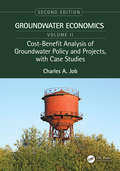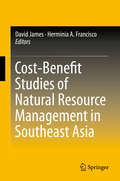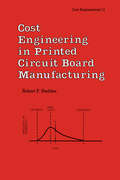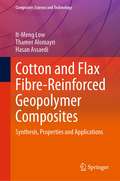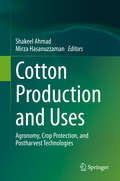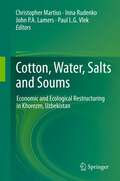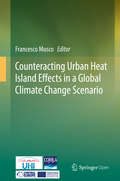- Table View
- List View
Cost-Benefit Analysis: Cases and Materials
by Euston Quah Raymond TohCost-benefit analysis (CBA) is the systematic and analytical process of comparing benefits and costs in evaluating the desirability of a project or programme, often of a social nature and for society as a whole. CBA is fundamental to government decision-making and can be an effective tool for informed decisions on the use of society's scarce resources. This book highlights the main concepts and principles of cost-benefit analysis used in real life cases and actual applications. The book contains rich cases, materials and examples of real life CBA applications with emphasis both on physical and non-physical projects and infrastructure developments in Asia and beyond. The book also discusses techniques frequently used in applied CBA. The first part of the book introduces the key concepts and principles of CBA before Part Two covers some pertinent issues relating to CBA, such as the recent trend of using behavioural economics and frequently used techniques in applied CBA. Finally, in Part Three, case studies are written up to illustrate how CBA is done, and questions for the readers and students to ponder are raised at the end of each chapter. The scope of the case studies is more than just physical infrastructures but will include public sector policies and programmes covering a host of social policies as in health, education, social welfare programmes, and the environment. For each case, there will be illustrations of the key concepts and principles of CBA used. Undertakings analyzed include: the Three Gorges Dam in China the 2008 Beijing Olympics the Costs of Global Warming the Jamuna Bridge in Bangladesh The case studies, many of which have taken or are to take place in developing countries provide a rich background to the principles of the method, and are accompanied by a wealth of explanatory material. As well as being suitable for courses in Cost-Benefit Analysis, Public Finance, Environmental and Health Economics, the book should be of interest to all public policy decision makers and planners.
Cost-Benefit Analysis of Groundwater Policy and Projects, with Case Studies: Groundwater Economics, Volume 2
by Charles A. JobThe competition for groundwater sources as a water supply reinforces the need for a strong economic rationale in decision-making. Evaluating economic decisions in the context of total water management and life-cycle water use is essential to making critical development and remediation choices. This revised volume provides fundamental economic and policy concepts related to groundwater, discusses important factors in life-cycle cost-benefit evaluation and explains triple-bottom-line analysis for different groundwater projects. It includes new and updated case studies on groundwater issues with solutions for a range of situations based on economic data. FEATURES OF THIS VOLUME Provides an understanding for the fundamental economic approaches to groundwater policy and project evaluation Incorporates life-cycle cost-benefit approaches in a triple-bottom-line framework Includes new case studies on the economics of health protection, managed aquifer recharge, local versus regional supply and strategic life-cycle analysis Addresses local and regional groundwater economic choices through a series of practical applications Explores transboundary, international, climate change and macroeconomic factors influencing groundwater project and program decisions Cost-Benefit Analysis of Groundwater Policy and Projects, with Case Studies, Second Edition, the second volume of the two-volume set Groundwater Economics, is a must-have for any professional or student who needs to understand and evaluate water resources and manage their use from a variety of sustainable approaches.
Cost-Benefit Analysis of Groundwater Policy and Projects, with Case Studies: Groundwater Economics, Volume 2
by Charles A. JobThe competition for groundwater sources as a water supply reinforces the need for a strong economic rationale in decision-making. Evaluating economic decisions in the context of total water management and life-cycle water use is essential to making critical development and remediation choices. This revised volume provides fundamental economic and policy concepts related to groundwater, discusses important factors in life-cycle cost-benefit evaluation and explains triple-bottom-line analysis for different groundwater projects. It includes new and updated case studies on groundwater issues with solutions for a range of situations based on economic data. FEATURES OF THIS VOLUME Provides an understanding for the fundamental economic approaches to groundwater policy and project evaluation Incorporates life-cycle cost-benefit approaches in a triple-bottom-line framework Includes new case studies on the economics of health protection, managed aquifer recharge, local versus regional supply and strategic life-cycle analysis Addresses local and regional groundwater economic choices through a series of practical applications Explores transboundary, international, climate change and macroeconomic factors influencing groundwater project and program decisions Cost-Benefit Analysis of Groundwater Policy and Projects, with Case Studies, Second Edition, the second volume of the two-volume set Groundwater Economics, is a must-have for any professional or student who needs to understand and evaluate water resources and manage their use from a variety of sustainable approaches.
Cost-Benefit Studies of Natural Resource Management in Southeast Asia
by David James Herminia A. FranciscoThis book applies cost-benefit analysis techniques in the management of environment and natural resources in developing countries of the Southeast Asian region and presents a compendium of studies conducted by researchers supported by the Economy and Environment Program for Southeast Asia (EEPSEA). It emphasizes the close relationship between the environment and natural resources and economic development in such countries, addressing a wide range of problems that can be understood using economic evaluation techniques. General guidelines for conducting economic appraisals are provided, with the case studies illustrating how they can be applied in a developing country context. Cost-Benefit Analysis Application in Environmental and Natural Resource Management in Southeast Asia serves as essential reading for teachers, researchers, students and practitioners in environmental and natural resource economics, economic development and key issues facing policymakers in the Southeast Asian region.
Cost-efficient Wastewater Treatment Technologies: Natural Systems (The Handbook of Environmental Chemistry #117)
by Mahmoud Nasr Abdelazim M. NegmThis is the first of two volumes that together provide a comprehensive overview of the current sustainable and low-cost wastewater treatment technologies applied in communities that lack the financial and technical resources needed for an environmental, disease prevention and health nexus.This book reviews natural wastewater treatment technologies and traces the current challenges in wastewater management and sustainability. Divided into 4 themed parts, the chapters from expert contributors cover topics such as simplified and low-energy natural treatment facilities, bioremediation and biotechnology for green future, environmental impact assessment of wastewater reuse, wastewater management and sustainability for irrigation, high-performance and cost-effective biosorbents for heavy metals removal, and eco-friendly nanomaterials for wastewater environmental management. The readers will discover essential recommendations for improving natural treatment systems to withstand emerging contaminants, namely, endocrine disruption chemicals, surfactants, personal care products, pesticides, and pharmaceuticals. Readers will also find valuable guidelines to ensure sustainable and innovative solutions for wastewater treatment in the light of climate change, resource, demand, and funding challenges.Given the breadth and depth of its coverage, the book offers an invaluable source of information for researchers, students and environmental managers alike.
Cost-efficient Wastewater Treatment Technologies: Engineered Systems (The Handbook of Environmental Chemistry #118)
by Mahmoud Nasr Abdelazim M. NegmThis is the second of two volumes that together provide a comprehensive overview of the current sustainable and low-cost wastewater treatment technologies applied in communities that lack the financial and technical resources needed for an environmental, disease prevention and health nexus. This book reviews engineered wastewater treatment technologies and discusses their application in regard to greenhouse gas emissions, natural resource utilization, land-use, and energy and water savings. The chapters from expert contributors cover topics such as aerobic and anaerobic biological treatments, chemical treatments and precipitation, and disinfection. Readers will also learn about simplified and low-energy wastewater treatment plants, strategies for wastewater reuse, and nanotechnologies for wastewater environmental management. The feasibility regarding time and cost of implementing such technologies is also discussed in this book, and particular attention is given to the removal of conventional and emerging pollutants, toxicants, and heavy metals. Given the breadth and depth of its coverage, the book offers an invaluable source of information for researchers, students and environmental managers alike.
Cost Engineering in Printed Circuit Board Manufacturing
by R. P. HeddenThis book is intended as an introduction to printed circuit board manufacturing processes and terminology for readers who have no exposure to them. It provides techniques and approaches to estimating that should prove useful to all who participate in the estimating process.
Cost Engineering in Printed Circuit Board Manufacturing
by R. P. HeddenThis book is intended as an introduction to printed circuit board manufacturing processes and terminology for readers who have no exposure to them. It provides techniques and approaches to estimating that should prove useful to all who participate in the estimating process.
Costa Rican Ecosystems
by Rodrigo Gámez LoboIn the more than thirty years since the publication of Daniel H. Janzen’s classic Costa Rican Natural History, research in this small but astonishingly biodiverse, well-preserved, and well-studied Latin American nation has evolved from a species-level approach to the study of entire ecosystems. And from the lowland dry forests of Guanacaste to the montane cloud forests of Monteverde, from the seasonal forests of the Central Valley to the coastal species assemblages of Tortuguero, Costa Rica has proven to be as richly diverse in ecosystems as it is in species. In Costa Rican Ecosystems, Maarten Kappelle brings together a collection of the world’s foremost experts on Costa Rican ecology—outstanding scientists such as Daniel H. Janzen, Jorge Cortés, Jorge A. Jiménez, Sally P. Horn, Robert O. Lawton, Quírico Jiménez M., Carlos Manuel Rodríguez, Catherine M. Pringle, and Eduardo Carrillo J., among others—to offer the first comprehensive account of the diversity, structure, function, uses, and conservation of Costa Rica’s ecosystems. Featuring a foreword and introductory remarks by two renowned leaders in biodiversity science and ecological conservation, Thomas E. Lovejoy and Rodrigo Gámez Lobo, in addition to chapters highlighting the geology, soils, and climate of Costa Rica, as well as the ecosystems of its terrestrial, freshwater, and marine habitats, and including previously unpublished information on Isla del Coco, this beautiful color-illustrated book will be an essential reference for academic scientists, students, natural history guides, conservationists, educators, park guards, and visitors alike.
Costa Rican Ecosystems
by Rodrigo Gámez LoboIn the more than thirty years since the publication of Daniel H. Janzen’s classic Costa Rican Natural History, research in this small but astonishingly biodiverse, well-preserved, and well-studied Latin American nation has evolved from a species-level approach to the study of entire ecosystems. And from the lowland dry forests of Guanacaste to the montane cloud forests of Monteverde, from the seasonal forests of the Central Valley to the coastal species assemblages of Tortuguero, Costa Rica has proven to be as richly diverse in ecosystems as it is in species. In Costa Rican Ecosystems, Maarten Kappelle brings together a collection of the world’s foremost experts on Costa Rican ecology—outstanding scientists such as Daniel H. Janzen, Jorge Cortés, Jorge A. Jiménez, Sally P. Horn, Robert O. Lawton, Quírico Jiménez M., Carlos Manuel Rodríguez, Catherine M. Pringle, and Eduardo Carrillo J., among others—to offer the first comprehensive account of the diversity, structure, function, uses, and conservation of Costa Rica’s ecosystems. Featuring a foreword and introductory remarks by two renowned leaders in biodiversity science and ecological conservation, Thomas E. Lovejoy and Rodrigo Gámez Lobo, in addition to chapters highlighting the geology, soils, and climate of Costa Rica, as well as the ecosystems of its terrestrial, freshwater, and marine habitats, and including previously unpublished information on Isla del Coco, this beautiful color-illustrated book will be an essential reference for academic scientists, students, natural history guides, conservationists, educators, park guards, and visitors alike.
Costa Rican Ecosystems
by Rodrigo Gámez LoboIn the more than thirty years since the publication of Daniel H. Janzen’s classic Costa Rican Natural History, research in this small but astonishingly biodiverse, well-preserved, and well-studied Latin American nation has evolved from a species-level approach to the study of entire ecosystems. And from the lowland dry forests of Guanacaste to the montane cloud forests of Monteverde, from the seasonal forests of the Central Valley to the coastal species assemblages of Tortuguero, Costa Rica has proven to be as richly diverse in ecosystems as it is in species. In Costa Rican Ecosystems, Maarten Kappelle brings together a collection of the world’s foremost experts on Costa Rican ecology—outstanding scientists such as Daniel H. Janzen, Jorge Cortés, Jorge A. Jiménez, Sally P. Horn, Robert O. Lawton, Quírico Jiménez M., Carlos Manuel Rodríguez, Catherine M. Pringle, and Eduardo Carrillo J., among others—to offer the first comprehensive account of the diversity, structure, function, uses, and conservation of Costa Rica’s ecosystems. Featuring a foreword and introductory remarks by two renowned leaders in biodiversity science and ecological conservation, Thomas E. Lovejoy and Rodrigo Gámez Lobo, in addition to chapters highlighting the geology, soils, and climate of Costa Rica, as well as the ecosystems of its terrestrial, freshwater, and marine habitats, and including previously unpublished information on Isla del Coco, this beautiful color-illustrated book will be an essential reference for academic scientists, students, natural history guides, conservationists, educators, park guards, and visitors alike.
Costa Rican Ecosystems
by Rodrigo Gámez LoboIn the more than thirty years since the publication of Daniel H. Janzen’s classic Costa Rican Natural History, research in this small but astonishingly biodiverse, well-preserved, and well-studied Latin American nation has evolved from a species-level approach to the study of entire ecosystems. And from the lowland dry forests of Guanacaste to the montane cloud forests of Monteverde, from the seasonal forests of the Central Valley to the coastal species assemblages of Tortuguero, Costa Rica has proven to be as richly diverse in ecosystems as it is in species. In Costa Rican Ecosystems, Maarten Kappelle brings together a collection of the world’s foremost experts on Costa Rican ecology—outstanding scientists such as Daniel H. Janzen, Jorge Cortés, Jorge A. Jiménez, Sally P. Horn, Robert O. Lawton, Quírico Jiménez M., Carlos Manuel Rodríguez, Catherine M. Pringle, and Eduardo Carrillo J., among others—to offer the first comprehensive account of the diversity, structure, function, uses, and conservation of Costa Rica’s ecosystems. Featuring a foreword and introductory remarks by two renowned leaders in biodiversity science and ecological conservation, Thomas E. Lovejoy and Rodrigo Gámez Lobo, in addition to chapters highlighting the geology, soils, and climate of Costa Rica, as well as the ecosystems of its terrestrial, freshwater, and marine habitats, and including previously unpublished information on Isla del Coco, this beautiful color-illustrated book will be an essential reference for academic scientists, students, natural history guides, conservationists, educators, park guards, and visitors alike.
Costa Rican Ecosystems
by Rodrigo Gámez LoboIn the more than thirty years since the publication of Daniel H. Janzen’s classic Costa Rican Natural History, research in this small but astonishingly biodiverse, well-preserved, and well-studied Latin American nation has evolved from a species-level approach to the study of entire ecosystems. And from the lowland dry forests of Guanacaste to the montane cloud forests of Monteverde, from the seasonal forests of the Central Valley to the coastal species assemblages of Tortuguero, Costa Rica has proven to be as richly diverse in ecosystems as it is in species. In Costa Rican Ecosystems, Maarten Kappelle brings together a collection of the world’s foremost experts on Costa Rican ecology—outstanding scientists such as Daniel H. Janzen, Jorge Cortés, Jorge A. Jiménez, Sally P. Horn, Robert O. Lawton, Quírico Jiménez M., Carlos Manuel Rodríguez, Catherine M. Pringle, and Eduardo Carrillo J., among others—to offer the first comprehensive account of the diversity, structure, function, uses, and conservation of Costa Rica’s ecosystems. Featuring a foreword and introductory remarks by two renowned leaders in biodiversity science and ecological conservation, Thomas E. Lovejoy and Rodrigo Gámez Lobo, in addition to chapters highlighting the geology, soils, and climate of Costa Rica, as well as the ecosystems of its terrestrial, freshwater, and marine habitats, and including previously unpublished information on Isla del Coco, this beautiful color-illustrated book will be an essential reference for academic scientists, students, natural history guides, conservationists, educators, park guards, and visitors alike.
Costa Rican Ecosystems
by Rodrigo Gámez LoboIn the more than thirty years since the publication of Daniel H. Janzen’s classic Costa Rican Natural History, research in this small but astonishingly biodiverse, well-preserved, and well-studied Latin American nation has evolved from a species-level approach to the study of entire ecosystems. And from the lowland dry forests of Guanacaste to the montane cloud forests of Monteverde, from the seasonal forests of the Central Valley to the coastal species assemblages of Tortuguero, Costa Rica has proven to be as richly diverse in ecosystems as it is in species. In Costa Rican Ecosystems, Maarten Kappelle brings together a collection of the world’s foremost experts on Costa Rican ecology—outstanding scientists such as Daniel H. Janzen, Jorge Cortés, Jorge A. Jiménez, Sally P. Horn, Robert O. Lawton, Quírico Jiménez M., Carlos Manuel Rodríguez, Catherine M. Pringle, and Eduardo Carrillo J., among others—to offer the first comprehensive account of the diversity, structure, function, uses, and conservation of Costa Rica’s ecosystems. Featuring a foreword and introductory remarks by two renowned leaders in biodiversity science and ecological conservation, Thomas E. Lovejoy and Rodrigo Gámez Lobo, in addition to chapters highlighting the geology, soils, and climate of Costa Rica, as well as the ecosystems of its terrestrial, freshwater, and marine habitats, and including previously unpublished information on Isla del Coco, this beautiful color-illustrated book will be an essential reference for academic scientists, students, natural history guides, conservationists, educators, park guards, and visitors alike.
Costs of Air Pollution Control: Analyses of Emission Control Options for Ozone Abatement Strategies
by Stefan ReisThis book describes the development of cost effective abatement strategies aimed at controlling air pollutant emissions in Europe, particularly ground level ozone. The author gives a thorough evaluation of the results achieved for different environmental targets, and proposes a modelling scheme for emission targets required to achieve compliance with EU thresholds, and calculations reveal the need to review established ozone thresholds and emission limits.
Costs of Ammonia Abatement and the Climate Co-Benefits
by Stefan Reis Clare Howard Mark A. SuttonThis book examines the costs involved in reducing ammonia emissions from agricultural practices as well as the potential benefits for climate change mitigation. It features contributions by experts in agricultural production processes, producers of agricultural equipment and service providers as well as scientists who assess the issue from an European perspective. Coverage examines all agricultural production stages starting from animal feed and housing, including the storage and application of liquid and solid manure and of mineral fertilizer. In addition, the book looks at the relationship between ammonia control and greenhouse gas emissions and details the GAINS (Greenhouse Gas and Air Pollution Interactions and Synergies) model for estimating costs and reducing ammonia emissions from agriculture. Examples and case studies from select European countries, including Italy, Switzerland, Russia, Ireland, and Spain, provide readers with detailed studies of ammonia abatement costs and the effectiveness of implementing control measures under different conditions. This book is the result of an Expert Workshop held under the auspices of the UNECE Convention on Long-range Transboundary Air Pollution (CLRTAP) and organised by the Task Force on Reactive Nitrogen (TFRN). The findings of this workshop have informed the development of documents supporting the revision of the Gothenburg Protocol and provided researchers and practitioners with vital new data. Bringing together a wealth of key information on the costs of ammonia abatement and the climate co-benefits, this monograph provides readers with deep insight into this complex issue.
Cotton and Flax Fibre-Reinforced Geopolymer Composites: Synthesis, Properties and Applications (Composites Science and Technology)
by It-Meng Low Thamer Alomayri Hasan AssaediThis book provides an overview on the latest advances in the synthesis, properties and applications of geopolymers reinforced with natural fibres such as pulp fibre, cotton, sisal, flax and hemp. The influence of adding various natural fibres and nanofillers on the mechanical properties of these composites is discussed. Potential challenges and future directions of these composites are highlighted and addressed. The content of this book caters to students, researchers and academics who are interested in the synthesis and applications of geopolymers composites.
The Cotton Plantation South since the Civil War (Creating the North American Landscape)
by Charles S. AikenOriginally published in 1998. "The plantation," writes Charles Aiken, "is among the most misunderstood institutions of American history. The demise of the plantation has been pronounced many times, but the large industrial farms survive as significant parts of, not just the South's, but the nation's agriculture."In this sweeping historical and geographical account, Aiken traces the development of the Southern cotton plantation since the Civil War—from the emergence of tenancy after 1865, through its decline during the Depression, to the post-World War Two development of the large industrial farm.Tracing the geographical changes in plantation agriculture and the plantation regions after 1865, Aiken shows how the altered landscape of the South has led many to the false conclusion that the plantation has vanished. In fact, he explains, while certain regions of the South have reverted to other uses, the cotton plantation survives in a form that is, in many ways, remarkably similar to that of its antebellum predecessors.Aiken also describes the evolving relationship of African-Americans to the cotton plantation during the thirteen decades of economic, social, and political changes from Reconstruction through the War on Poverty—including the impact of alterations in plantation agriculture and the mass migration of Southern blacks to the urban North during the twentieth century.Richly illustrated with more than 130 maps and photographs (many original and many from FSA photographers), The Cotton Plantation South is a vivid and colorful account of landscape, geography, race, politics, and civil rights as they relate to one of America's most enduring and familiar institutions.
Cotton Production and Uses: Agronomy, Crop Protection, and Postharvest Technologies
by Mirza Hasanuzzaman Shakeel AhmadThis book provides a comprehensive and systematic overview of the recent developments in cotton production and processing, including a number of genetic approaches, such as GM cotton for pest resistance, which have been hotly debated in recent decades. In the era of climate change, cotton is facing diverse abiotic stresses such as salinity, drought, toxic metals and environmental pollutants. As such, scientists are developing stress-tolerant cultivars using agronomic, genetic and molecular approaches. Gathering papers on these developments, this timely book is a valuable resource for a wide audience, including plant scientists, agronomists, soil scientists, botanists, environmental scientists and extention workers.
Cotton, Water, Salts and Soums: Economic and Ecological Restructuring in Khorezm, Uzbekistan
by Christopher Martius, Inna Rudenko, John P.A. Lamers and P.L.G. VlekThis book summarizes a long-term research project addressing land and water use in the irrigated areas of the Aral Sea basin. In an interdisciplinary approach, natural and human sciences are combined to elucidate the challenges of economic transition that affect the use of land, water and biological resources, ecological sustainability, economic efficiency and the livelihoods of the local population. The research focuses on Khorezm, a region in Uzbekistan, located on the Amudarya river, in the heart of Central Asia. A series of chapters describes the biophysical environment and the aspects of society and institutions that shape land and water use. The book discusses options and tools to improve land and water management, and to reform the economic system management, based on agronomic, hydrological, economic ans social studies and modeling. The insights are not only important for Uzbekistan, but for all countries in transitions and irrigated dryland areas elsewhere.
Counter Revanchist Art in the Global City: Walls, Blockades, and Barricades as Repertoires of Creative Action (Routledge Studies in Urbanism and the City)
by Leah ModiglianiThrough analyses of public artworks that have taken the form of blockades and barricades since the 1990s, this book theorises artists’ responses to global inequities as cultural manifestations of counter-revanchism in diverse urban centres. This book is the first to analyse artworks as forms of counter-revanchism in the context of the rise of the global city. How do artists channel the global spatial conflicts of the 21st century through their behaviours, actions, and constructions in and on the actually existing conditions of the street? What does it mean for artists—the very symbol of freedom of personal expression—to shut down space? To refuse entry? To block others’ passage? The late critical geographer Neil Smith’s influential writing on the revanchist city is used as a theoretical frame for understanding how contemporary artists engender the public sphere through their work in public urban spaces. Each chapter is a case study that analyses artworks that have taken the form of walls and barricades in China, USA, UK, Ukraine, and Mexico. In doing so, the author draws upon diverse fields including art history, geography, philosophy, political science, theatre studies, and urban studies to situate the art in a broader context of the humanities with the aim of modelling interdisciplinary research grounded in an ethics of solidarity with global social justice work. Collectively these case studies reveal how artists’ local responses to urban revanchism since the end of the Cold War are productive reorientations of social relations and harbingers of worlds to come. By using plain language and avoiding excessive academic jargon, the book is accessible to a wide variety of readers. It will appeal to scholars and graduate students in the fields of studio art, modern and contemporary art history, performance studies, visual culture, and visual studies; especially in relation to those interested in conceptual practices, performance art, site-specificity, public art, political activism, and socially engaged art. Cultural geographers and urban theorists interested in the social and political ramifications of temporary and everyday urbanism will also find the analysis of artworks relevant to their own studies.
Counter Revanchist Art in the Global City: Walls, Blockades, and Barricades as Repertoires of Creative Action (Routledge Studies in Urbanism and the City)
by Leah ModiglianiThrough analyses of public artworks that have taken the form of blockades and barricades since the 1990s, this book theorises artists’ responses to global inequities as cultural manifestations of counter-revanchism in diverse urban centres. This book is the first to analyse artworks as forms of counter-revanchism in the context of the rise of the global city. How do artists channel the global spatial conflicts of the 21st century through their behaviours, actions, and constructions in and on the actually existing conditions of the street? What does it mean for artists—the very symbol of freedom of personal expression—to shut down space? To refuse entry? To block others’ passage? The late critical geographer Neil Smith’s influential writing on the revanchist city is used as a theoretical frame for understanding how contemporary artists engender the public sphere through their work in public urban spaces. Each chapter is a case study that analyses artworks that have taken the form of walls and barricades in China, USA, UK, Ukraine, and Mexico. In doing so, the author draws upon diverse fields including art history, geography, philosophy, political science, theatre studies, and urban studies to situate the art in a broader context of the humanities with the aim of modelling interdisciplinary research grounded in an ethics of solidarity with global social justice work. Collectively these case studies reveal how artists’ local responses to urban revanchism since the end of the Cold War are productive reorientations of social relations and harbingers of worlds to come. By using plain language and avoiding excessive academic jargon, the book is accessible to a wide variety of readers. It will appeal to scholars and graduate students in the fields of studio art, modern and contemporary art history, performance studies, visual culture, and visual studies; especially in relation to those interested in conceptual practices, performance art, site-specificity, public art, political activism, and socially engaged art. Cultural geographers and urban theorists interested in the social and political ramifications of temporary and everyday urbanism will also find the analysis of artworks relevant to their own studies.
Counteracting Urban Heat Island Effects in a Global Climate Change Scenario
by Francesco MuscoUrban heat islands are a new type of microclimatic phenomenon that causes a significant increase in the temperature of cities compared to surrounding areas. The phenomenon has been enforced by the current trend towards climate change. Although experts consider urban heat islands an urgent European Union public health concern, there are too few policies that address it. The EU carried out a project to learn more about this phenomenon through pilot initiatives. The pilots included feasibility studies and strategies for appropriately altering planning rules and governance to tackle the problem of urban heat islands. The pilots were carried out in eight metropolitan areas: Bologna/Modena, Budapest, Ljubljana, Lodz, Prague, Stuttgart, Venice/Padova, and Vienna. The feasibility studies carried out in these pilot areas focused on the specific morphology of EU urban areas, which are often characterised by the presence of historical old towns.
Countering 21st Century Social-Environmental Threats to Growing Global Populations (SpringerBriefs in Environmental Science)
by Frederic R. SiegelThis book brings together in a single volume a grand overview of solutions - political, economic, and scientific - to social and environmental problems that are related to the growth of human populations in areas that can least cope with them now. Through progressive adaptation to social and environmental changes projected for the future, including population growth, global warming/climate change, water deficits, and increasing competition for other natural resources, the world may be able to achieve a fair degree of sustainability for some time into the future.
Counterterrorism and Open Source Intelligence (Lecture Notes in Social Networks)
by Uffe Kock WiilSince the 9/11 terrorist attacks in the United States, serious concerns were raised on domestic and international security issues. Consequently, there has been considerable interest recently in technological strategies and resources to counter acts of terrorism. In this context, this book provides a state-of-the-art survey of the most recent advances in the field of counterterrorism and open source intelligence, demonstrating how various existing as well as novel tools and techniques can be applied in combating covert terrorist networks. A particular focus will be on future challenges of open source intelligence and perspectives on how to effectively operate in order to prevent terrorist activities.

